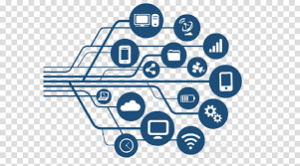
The senior living industry is about to experience a major tech transformation, according to the Perkins Eastman 2019 report “The State of Senior Living”. In a survey conducted among approximately 200 C-suite industry leaders, technology emerged as the second biggest disruptor for the industry.
But how exactly can technology disrupt senior living and what does it mean for the future of senior living communities?
Remote care and monitoring
From “smart” spoons for seniors that will offset the hand tremor to automated medication reminders, technology can offer ingenious solutions for caregiving. But with the growing availability of the Internet of Things (IoT), the potential grows tremendously.
Connected devices allow for real-time remote monitoring and caregiving in a way we haven’t seen before. A smart insulin pump, for example, takes regular blood sugar readings and adjusts the insulin dose for the patients, preventing lows and highs. But that’s not all. The same pump can be connected to an app and send regular updates to a caregiver with insights and stats.
IoT caregiving can also come in the form of sensors and cameras that detect a fall and automatically alert the caregivers and/or the nearest hospital. Such technology would increase the level of autonomy of seniors both living at home and in senior living communities.
But all these benefits aside, it’s important to remember that connected device security remains an issue. The stories of hackable insulin pumps, hijacked pacemakers, and stolen sensitive data serve as a warning to curb our optimism about this technology.
Until there are better security testing and more stringent regulations, seniors and caregivers can still take action to increase security. Changing the pre-installed password is always a good first step as manufacturers tend to ship all devices with the same password. Another strategy is installing a VPN on the Wi-Fi router in the senior living community. A VPN encrypts all traffic coming in and out of the devices, securing the data from snooping eyes and making it more difficult for hackers to infiltrate.
Data management
With blockchain gaining ground, implementing this technology for business becomes more feasible. For senior and assisted living facilities, this might mean improvements in data management.
Blockchain’s biggest selling point is that it’s decentralized and immutable. That means that once a data is input in the system, no one can change it without it leaving a trace back to them. These qualities would make it easier for a facility to manage data across several locations. It also reduces the chance of fraud and increases trust between various stakeholders, including insurance companies, healthcare organizations, and seniors’ families.
Staying out of care longer
In the long run, technology might actually keep seniors out of senior living facilities longer. This is not only thanks to advanced remote care methods but also better prevention.
Fitness trackers and other devices allow users to get to know their bodies better and strive for a healthier lifestyle. They can also help with earlier detection of common issues such as high blood pressure or high cholesterol. With movements such as Quantified Self inspiring people to gain data insights on their health, the future seniors have a chance of staying in shape longer and being more aware of their health condition.
Senior living communities of the future
The future of senior living communities and senior facilities is likely going to look very different from the present. Seniors will be given more autonomy while, paradoxically, being monitored more than ever. Caregivers and family members will receive updates and data insights that are collected automatically.
What is important to keep in mind is that more data creates more challenges. To some extent, blockchain can come to the rescue here, providing a single source of truth for all stakeholders and protecting data from fraud. But cybersecurity will remain a serious threat and ensuring device safety will need to be on every caregiver’s agenda.